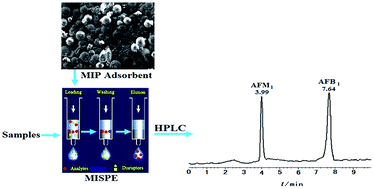Molecularly imprinted solid phase extraction coupled to high performance liquid chromatography for determination of aflatoxin M1 and B1 in foods and feeds
Abstract
A molecularly imprinted polymer was synthesized by a miniemulsion polymerization method using aflatoxin B1 as the molecular template, methacrylic acid (MAA) as the functional monomer, ethylene glycol dimethacrylate as the cross-linker, Span80 and hexadecyl trimethyl ammonium bromide as the surfactants and n-hexadecane as the hydrophobic reagent in the presence of water. This imprinted polymer was characterized by FT-IR, 1H NMR, scanning electron microscopy, laser light scattering and adsorption experiments, in which the results showed good recognition and selectivity to aflatoxin B1 and M1. Using the prepared polymer as a solid phase extraction sorbent, a highly selective sample pre-treatment method combined with high performance liquid chromatography and fluorescence detection was developed for determination of aflatoxin B1 and M1 in foods and feeds. The limit of detection and limit of quantification of this method for aflatoxins M1 and B1 were 0.05 μg kg−1 and 0.16 μg kg−1, respectively. The average recovery values from barley, peanut oil, feed and beer spiked samples ranged from 83% to 96%. The precision ranged from 2.2% to 5.6% for these samples. The proposed method was found to be more effective and economical as a pre-treatment technique than regulation 2006/40/EC.


 Please wait while we load your content...
Please wait while we load your content...